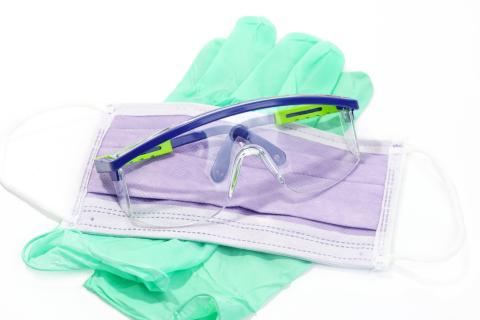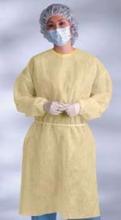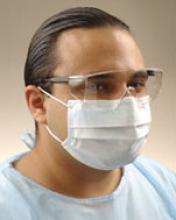Healthcare-Associated Infections: Personal Protective Equipment (PPE)
Personal protective equipment (PPE) is specialized clothing or equipment used to prevent exposure to communicable diseases. PPE use is an integral infection control and prevention measure that protects health care personnel from exposure to blood, body fluids, and other potentially infectious materials. PPE, such as gowns, gloves, masks, and goggles, provides a physical barrier that to prevent the hands, skin, clothing, eyes, nose, and mouth from contacting infectious agents. PPE is used to reduce transmission of communicable diseases when other measures, such as engineering controls and work practices, cannot completely eliminate exposure.
Employers are required by the Occupational Safety and Health Administration (OSHA) standard 29 CFR Part 1910.132 to assess the workplace for hazards that necessitate the use of PPE and document that such an assessment has taken place. Employers should maintain written PPE policies and procedures, review them annually, and update them as needed. They must also provide appropriate PPE in the workplace, store and maintain PPE in good working order, train employees on proper use of PPE, and ensure that employees use PPE appropriately.
In health care settings, these items must be readily available at all times for use by employees with exposure to communicable diseases. Employers must conduct initial training prior to use of PPE and thereafter when an employer has reason to believe that an employee does not have appropriate understanding of the use of PPE, or when there are changes in the workplace or types of PPE rendering previous training obsolete. Per the CDC (Centers for Disease Control and Prevention) Infection Control Assessment and Response (ICAR) assessments, PPE retraining and competency is recommended annually in all health care facilities.
Types of PPE
Wear clean disposable gloves during direct contact with:
- Blood and body fluids.
- Mucous membranes.
- Non-intact skin.
- Any other potentially infectious material.
You should also wear gloves as a part of standard and contact precautions when entering a patient or resident room and when in contact with the individual, surfaces, or objects within their environment.
Disposable gloves are available in latex, vinyl, and nitrile materials. Since many individuals are allergic to latex, vinyl or nitrile gloves are recommended alternatives.
Note: Vinyl gloves can be used for brief patient contact, but nitrile gloves are recommended for extended patient care activities.
Gowns are used to protect the clothing and arms of health care workers. Gowns are worn as part of standard and contact precautions.
- When used for standard precautions, gowns are worn only if contact with blood or body fluids is expected.
- When used for contact precautions, gowns are worn during all patient or resident contact and when in the patient's or resident’s environment.
Gowns are always worn in combination with gloves, and with other PPE when indicated. Remove at the point of use and discard disposable gowns or place cloth gowns in a laundry container.
Masks are used to protect the mouth and nose from splashes or sprays of blood or bodily fluids and from respiratory secretions. Masks are worn as part of standard, contact, droplet, and airborne precautions.
There are different types of masks that may be used depending on the nature of the exposure and risk involved:
- Surgical and procedure masks: These masks provide protection from large respiratory droplets. They are also used for source control.
- Respirators (such as N95, N99, or N100): Respirators filter contaminates from the air. They are capable of excluding particles that are less than 5 microns in diameter.
- Powered air-purifying respirators (PAPRs): These are battery-powered respirators in which a blower moves the air through the filters to the user.
For more information on the use of respirators, visit the Respiratory Protection Program webpage.
Goggles or face shields are used to protect eyes from splashes or sprays of blood or body fluids. Eye protection should be worn as part of standard and contact precautions based on anticipated risk and the types of activities being performed.
Personal eyeglasses or contact lenses are not considered adequate eye protection. Goggles and face shields should wrap around the sides of the face to protect against splashes from all angles.
Note: If PPE is being worn to protect against the spraying or splashing of a bloodborne pathogen, then all mucous membranes must be covered with a face shield or a mask and goggles.
Donning and doffing PPE
It is important to don (put on) and doff (take off) PPE properly to ensure optimal protection and reduce the risk of exposure. It is also important to practice proper hand hygiene prior to and after removing all PPE.
Refer to the CDC PPE donning and doffing sequence (PDF).
PPE storage
Generally, PPE should be stored in a dry area at room temperature where it can be protected from dust, moisture, and other contamination. Check with the manufacturer for more specific storage conditions. Some items may have expiration dates and require stock rotation to avoid outdating.
Resources
DHS Hand Hygiene and PPE Observations, F-02726 (PDF): Download the adaptable tool for conducting hand hygiene and PPE audits.
The following Policy Statement for PPE was developed by a Division of Public Health PPE expert panel in 2008.
- The ability to properly select, use and maintain necessary personal protective equipment is a core competency of public health professionals as defined by the Council on Linkages Between Academia and Public Health Practice.
- The Occupational Safety and Health Administration (OSHA) and the Wisconsin Department of Safety and Professional Services (DSPS) regulate PPE use in the workplace, including public health agencies, per OSHA General PPE Requirements Standard 29 CFR 1910 Subpart I and Wisconsin Administrative Code Chapter SPS 332.
- Local health departments are responsible for following the standards for PPE set forth the by OSHA General PPE Standard 29CFR1910 Subpart I and Wis. Admin. Code ch. SPS 332.
- Avoidance of a hazard should always be the first course of action. When this is not feasible, attempts should be made to engineer a solution to prevent personal exposure or to otherwise isolate the hazard.
- When engineering and workplace hazards are not effective, use PPE. PPE should be used as a last resort to protect against a hazard. PPE devices alone should not be relied on to provide protection against hazards, but should be used in conjunction with engineering controls and sound work practices.
- Health care workers and other volunteers assigned to assist in a public health emergency will be treated and provided the same protections as employees, under OSHA law.
Questions about HAIs? Contact us!
HAI home page | Phone: 608-267-7711 | Fax: 608-261-4976





